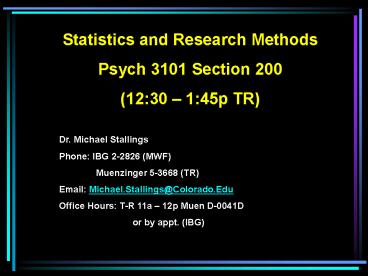Statistics and Research Methods - PowerPoint PPT Presentation
Title:
Statistics and Research Methods
Description:
Statistics and Research Methods. Psych 3101 Section 200 (12:30 1:45p ... The Detective' work! measurement and reliability. variability. sampling. probability ... – PowerPoint PPT presentation
Number of Views:86
Avg rating:3.0/5.0
Title: Statistics and Research Methods
1
Statistics and Research Methods Psych 3101
Section 200 (1230 145p TR)
Dr. Michael Stallings Phone IBG 2-2826
(MWF) Muenzinger 5-3668 (TR) Email
Michael.Stallings_at_Colorado.Edu Office Hours T-R
11a 12p Muen D-0041D or by appt. (IBG)
2
3 Teaching Assistants
- Jesse Hawke
- Friday 11-1250p (meets this week)
- Wed 11-1250p
- Huromi Sumiya
- Thurs 8-950a
- Thurs 10-1150a
- Joshua Madsen
- Tues 10-1150a
3
Course Objectives
- Facilitate critical evaluation of research
findings and the use of statistics in everyday
life - Facilitate intellectual access to scientific
journals and books - Provide an introduction to the conduct-ing and
reporting of psychological research - Provide an introduction to computerized data
analysis
4
Course Materials
Text Fundamental Statistics for the Behavioral
Sciences (5th Edition) by David
Howell Additional materials will be placed on
reserve in the library or provided as handouts
(text CD on reserve) Class list
http//psych.colorado.edu/courses.html
5
Course Requirements
- 12 Lab assignments
- 6 Quizzes
- 2 Midterms
- Final Exam (Saturday, May 1, 1030a 1p)
6
Laboratory Assignments 12 approximately weekly
assignments Friday Lab meets this week and will
meet the week before all other labs Assignments
due at the next lab meeting Assignments are
worth 10 points each 2 lowest scores will be
dropped total of 100 points no make-up for
missed labs
7
Quizzes
- Total of 6 quizzes
- Items taken from chapter exercises
- Quizzes will take place during Lab
- Each quiz will be worth 10 points
- Your lowest score will be dropped for a total of
50 points - Your overall lab grade will be based on both
assignments and quizzes for a total of 150 points
8
Exam Schedule
- Midterm I February 12
- Midterm 11 March 18 (Thurs. before Spring
Break!) - Final May 1 (Sat 1030a 1p)
9
Assessment and Grading
- Laboratory grade 30 150 pts
- Midterm I 20 100 pts
- Midterm II 20 100 pts
- Final Exam 30 150 pts
- Total Grade 500 pts
10
About This Course
- Not your typical psychology course
- More like a math class
- But it is not a math class!
- It will require
- regular class/lab attendance
- reading the text
- regular practice
- cumulative synthesis of material
11
Structure of Course
- Descriptive Statistics
- Introduction to Inferential Statistics
- Advanced Inferential Methods
12
Basic Terminology
13
The Meaning of Statistics
- Refers to a set of procedures and rules (not
always mathematical or computa-tional) for
summarizing data to allow us to draw inferences
or conclusions from the data - Statistics does not mean data
14
U.S. Homicide Victimization Rates per 100,000
Population by Age (U.S. Bureau of Justice)
lt14 14-17 18-24 25-34 35-49 50 1976 1.8 4.5 13.
8 15.4 12.6 6.5 1977 1.9 4.9 14.3 15.5 12.3 6.6 1
978 1.9 5.1 14.6 16.1 12.2 6.3 1979 1.7 5.3 14.8
15.9 12.1 6.2 . . . 1999 1.6 5.9 15.4
9.9 5.9 2.6 2000 1.4 4.7 14.9 10.2 5.7 2.5
15
(No Transcript)
16
Statistics
- 2 overlapping areas
- Descriptive Statistics
- Inferential Statistics
17
Descriptive Statistics
- Describe data
- average values
- measures of variability
- repeatability or reliability
- strength of association
18
Inferential Statistics
- Refer to tools for making inferences or
generalizations about data - The Detective work!
- measurement and reliability
- variability
- sampling
- probability
19
Population
- The entire collection of events in which you are
interested - Tail lengths of all cows
- Stress levels of all US adolescents
- Stress levels of students in this class
- Populations can range from a small set of numbers
to an infinitely large set of numbers
20
Sample
- Subset of a population
- Set of actual observations
- random sample
- sample bias
- representativeness
- nonrandom sample
21
Parameters and Statistics
- Parameters refer to populations, and statistics
to samples. - When we draw a sample of observations, we compute
statistics (e.g., average values) to summarize
the data in the sample. - The corresponding values in the population (e.g.,
population averages) are called parameters - The primary purpose of inferential statistics is
to draw inferences about populations (parameters)
from statistics (characteristics of the sample).
22
Generalizations From Data
- Statistical inferences
- Logical inferences

